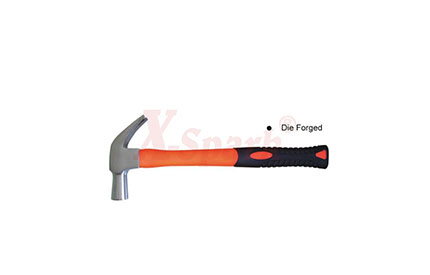 Crack hammer
Crack hammer
Tear hammers are commonly used for the frame and tear construction tasks. It is flatter than a claw hammer and is used to tear wood nailed together.
The curved claw hammer is a double-headed hammer used to hammer and pull out nails. One end of a curved claw hammer is deeper and the other side is flatter. This is usually used to pull out nails.
A split hammer is a heavy-duty tool, mainly used by professionals, while the angled claw hammer is a light-weight tool that ordinary users can use at home. Therefore, you will most likely use a claw hammer!
If a smaller blow is required when forming things such as metal plates, a rubber hammer is the most effective tool. In fact, it looks like a typical wooden or metal hammer, except that the head is equipped with a rubber coating. Therefore, any impact on the metal will not leave any marks on the material to be formed under a soft blow.
The typical design has a wooden handle and weighs 12 to 28 ounces. Rubber hammers are usually used to press tightly assembled wooden parts together, to change the position of gypsum board or for interior decoration. But in addition to this, a rubber hammer can also be used to form the metal plate, or the same tool can be used to remove or flatten the dent or metal sheet again. A perfect example of a rubber mallet being very suitable for use is to smooth out metal dents in a car. The following are the relevant steps.
Step 1-First assess the damage of the metal
Before starting to repair the metal or start a heavy blow, please evaluate the extent of the damage. Check for ripples, bumps, or creases. This is important because it will help you determine the level of effort required to level the metal and how long it will take.
Step 2-clean the area to be flattened
After assessing and determining the area to be flattened, remove all the dirt on the top of the metal so as not to merge the dirt with each stroke during the beating process. In most cases, it is recommended that you clean the area to be flattened. After washing, the area should be dried before starting to beat it. Except for dirt or grease, remove all items that may interfere with the entire ramming process. Do not use nails or other metal plates should be kept away from the work area.
Step 3-Put a suitable piece of wood on the metal
The block rests on the metal to help spread and evenly apply force each time the rubber mallet hits the metal. It should also be ensured that no traces are left on the metal during each blow. It is also important to wrap a piece of wood with a carpet so that the mallet will not leave any marks on the metal and will not damage the existing paint.
Step 4-start flattening the metal
When the block is in place, you can now start to flatten the metal. Before the first impact, it is usually recommended to cover the head or rubber part of the rubber mallet with a rubber blanket. This is also done to eliminate traces on the metal. It is important to always remember that taking some time will help achieve the best results.
Since a rubber hammer is often used because its impact on metal is relatively soft, it should be noted that the strike should be gentle, but with sufficient force. Hold the handle of the mallet firmly and hit the part that needs to be leveled. Before proceeding to the next stroke, make sure to observe the appropriate interval.
We are an adjustable stainless steel wrench supplier. If you are interested in our products, please feel free to contact us.
评论
发表评论